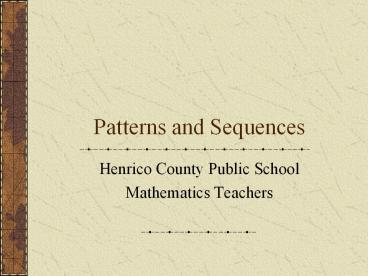Patterns and Sequences - PowerPoint PPT Presentation
Title:
Patterns and Sequences
Description:
For example: 3,6,9,12 and 15 are numbers that form a pattern called a sequence. ... in which the difference between any two consecutive numbers or expressions ... – PowerPoint PPT presentation
Number of Views:2372
Avg rating:3.0/5.0
Title: Patterns and Sequences
1
Patterns and Sequences
- Henrico County Public School
- Mathematics Teachers
2
Patterns and Sequences
- Patterns refer to usual types of procedures or
rules that can be followed. - Patterns are useful to predict what came before
or what might come after a set a numbers that are
arranged in a particular order. - This arrangement of numbers is called a sequence.
- For example 3,6,9,12 and 15 are numbers that
form a pattern called a sequence. - The numbers that are in the sequence are called
terms.
3
Patterns and Sequences
- Arithmetic sequence (arithmetic progression) a
sequence of numbers in which the difference
between any two consecutive numbers or
expressions is the same - Geometric sequence a sequence of numbers in
which each term is formed by multiplying the
previous term by the same number or expression
4
Arithmetic Sequence 1
Find the next three numbers or terms in each
pattern.
- Look for a pattern usually a procedure or rule
that uses the same number or expression each time
to find the next term. The pattern is to add 5
to each term.
5
The Next Three Numbers
- Add five to the last term
- The next three terms are
6
Arithmetic Sequence 2
Find the next three numbers or terms in each
pattern.
- Look for a pattern usually a procedure or rule
that uses the same number or expression each time
to find the next term. The pattern is to add the
integer (-3) to each term.
7
The Next Three Numbers 2
- Add the integer (-3) to each term
- The next three terms are
8
Geometric Sequence 1
Find the next three numbers or terms in each
pattern.
- Look for a pattern usually a procedure or rule
that uses the same number or expression each time
to find the next term. The pattern is to
multiply each term by three.
9
The Next Three 1
- Multiply each term by three
- The next three terms are
10
Geometric Sequence 2
Find the next three numbers or terms in each
pattern.
- Look for a pattern usually a procedure or rule
that uses the same number or expression each time
to find the next term. The pattern is to divide
each term by two.
11
The Next Three 2
- Divide each term by two
- The next three terms are
12
Note
- To divide by a number is the same as multiplying
by its reciprocal. - The pattern for a geometric sequence is
represented as a multiplication pattern. - For example to divide by 2 is represented as the
pattern multiply by a half.
13
Patterns Sequences
Decide the pattern for each and find the next
three numbers.
a) 7, 12, 17, 22, b) 1, 4, 7, 10, c) 2, 6,
18, 54, ... d) 20, 18, 16, 14, e) 64, 32, 16,
...
a) 27, 32, 37 b) 13, 16, 19 c) 162, 486,
1548 d) 12, 10, 8 e) 8, 4, 2































